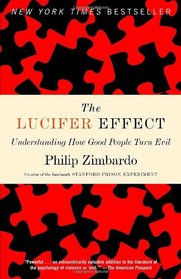Helpful Score: 2
As I read the first third of this book, I found myself entranced and absorbed into the Standford Prison Experiment, a project Dr. Zimbargo ran in 1971 to study the effects of deindividuation -- individuals losing their self-identity in a group. About 2 dozen students who underwent psychological evaluations to ensure they would bring inherently bad people into the experiment, i.e. the "bad apples" were filtered out to ensure the experiment was not corrupted, were recruited to play guards and prisoners. These were regular college men, many from top universities. The group was randomly divided into their new roles to form the Stanford Prison (Experiment), aka SPE.
When Zimbargo started the study, it was in search for deindividuation in the prisoners, however, he found it to be an influential quality in the guards as well in addition to other influences. During this first third of the book, the effects not of "bad apples" but of a "bad barrel" (a poorly run fake prison) corrupting the good apples within. What ensued was abuse, inhumane treatment, and well over two dozen people sucked into a fake prison that became all too real.
The remainder of the book investigates how and why the Standford Prison Experiment evolved the way it did. Why did college men from prestigious schools turned into sadistic "correctional officers"? Zimbargo leads the reader through many interesting -- and disturbing -- studies and historical instances that outline how regular people come to do evil deeds. The mountain of studies shows the SPE was no abnormality in how people behave
This book will (should) leave the reader asking several questions. What would I have done in each these situations? Would I be one of the small percentage of people who is resistant to the tendencies to fall into evil practices under the right (wrong) circumstances or would I fall in the majority that can lose their moral compass? Just as one of the many prisoners who endured abuse in the Stanford Prison Experiment admitted, we don't really know how we would act unless we were in that particular scenario. So instead of dwelling on this question we cannot answer, Zimbargo wants us to ask another question.
How can we make ourselves more resistant to a "bad barrel" that might turn us into "bad apples"? In the last chapter, Dr. Zimbargo describes several heroes who serve as examples, and he uses these to answer this final and important question about how we each can be both more resistant to the pressures that make ordinary people do bad things and how we can stand our ground to retain our moral.
When Zimbargo started the study, it was in search for deindividuation in the prisoners, however, he found it to be an influential quality in the guards as well in addition to other influences. During this first third of the book, the effects not of "bad apples" but of a "bad barrel" (a poorly run fake prison) corrupting the good apples within. What ensued was abuse, inhumane treatment, and well over two dozen people sucked into a fake prison that became all too real.
The remainder of the book investigates how and why the Standford Prison Experiment evolved the way it did. Why did college men from prestigious schools turned into sadistic "correctional officers"? Zimbargo leads the reader through many interesting -- and disturbing -- studies and historical instances that outline how regular people come to do evil deeds. The mountain of studies shows the SPE was no abnormality in how people behave
This book will (should) leave the reader asking several questions. What would I have done in each these situations? Would I be one of the small percentage of people who is resistant to the tendencies to fall into evil practices under the right (wrong) circumstances or would I fall in the majority that can lose their moral compass? Just as one of the many prisoners who endured abuse in the Stanford Prison Experiment admitted, we don't really know how we would act unless we were in that particular scenario. So instead of dwelling on this question we cannot answer, Zimbargo wants us to ask another question.
How can we make ourselves more resistant to a "bad barrel" that might turn us into "bad apples"? In the last chapter, Dr. Zimbargo describes several heroes who serve as examples, and he uses these to answer this final and important question about how we each can be both more resistant to the pressures that make ordinary people do bad things and how we can stand our ground to retain our moral.
Joe S. reviewed The Lucifer Effect: Understanding How Good People Turn Evil on + 2 more book reviews
Helpful Score: 1
Zimbardo wrote an excellent book here. Potential readers should be warned that he really goes into details on several topics, notably his Stanford Prison Experiment, so look elsewhere if you want a short text on this interesting question posed by the book's title.
Helpful Score: 1
I loved it! The results he gets from doing this expirment had me floored ... and the truth behind what he finds is so shocking, you'll wonder why you never thought about this before!! I don't want to say too much ... but if you are interested in learning about power, control, and the effects these (and other things) have when operating a group of "prisioners" ... THAN READ THIS BOOK!! It's SHOCKING!! I look at cops very differently, now, and i'm not sure that's always a good thing lol :)




![header=[] body=[Get a free book credit right now by joining the club and listing 5 books you have and are willing to share with other members!] Help icon](/images/question.gif?v=90afaeb39)
